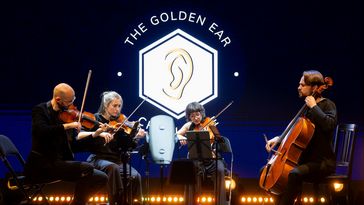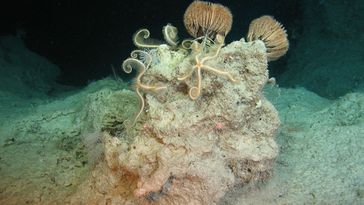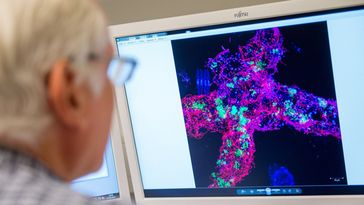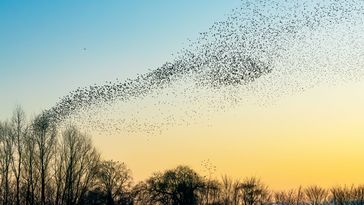Excellence Strategy
Excellence Strategy
The decision has been made: The University of Oldenburg has been successful in the Excellence Strategy of the federal government and the state governments: Three Clusters of Excellence have been granted.
- The hearing researchers from "Hearing4all" succeeded for the third time. The requested funding added up to 53.5 million euros. The Oldenburg team collaborated with hearing researchers from Hannover Medical School and Leibniz University Hannover to develop their proposal.
- The "NaviSense" cluster of excellence in animal navigation research has been funded for the first time. They had applied for funding totalling 54.7 million euros.
- Together with the University of Bremen, the University of Oldenburg was also successful in the field of marine research with its Cluster of Excellence 'Ocean Floor'. The total amount of funding requested was 54.2 million euros.
The successful performance in the Cluster of Excellence funding line paves the way for possible funding as a University of Excellence from 2027. The Universities of Oldenburg and Bremen have decided to apply for this funding together as joint partners.
Here is a look at what researchers in the three areas of excellence have already discovered in recent years, and what this means for our future and the future of our environment.
--------------
We would like to take this opportunity to express our thanks to zukunft.niedersachsen: With this joint funding programme, the Lower Saxony Ministry of Science and the VolkswagenStiftung support the state's universities in their application for funding under the Excellence Strategy from 2026. The University of Oldenburg has so far received a total of around 8 million euros for its preparations.
Field of excellence: hearing research
The scientists of the Hearing4all Cluster of Excellence and other groups specialised in hearing research at the university are all pursuing a common goal: to develop innovative solutions for people with impaired hearing and thus improve their quality of life in a sustainable way. These researchers have already successfully optimised sound quality and speech intelligibility in hearing aids, integrated artificial intelligence (AI) into hearing devices and made advances in cochlear implant technology. In the next phase they aim to find data-driven solutions for hearing aids, investigate the genetic causes of hearing loss with a view to developing new treatment options, and shed light on socio-communicative factors which impact hearing comprehension.
Further information and contacts
Cluster of Excellence "Hearing for All: Medicine, Basic Research and Technical Solutions for Personalized Hearing Support"
In collaboration with hearing researchers from Hannover Medical School and Leibniz University Hannover, the University of Oldenburg has successfully led the Excellence Cluster Hearing4all: Models, Technology and Solutions for Diagnostics, Restoration and Support of Hearing’ since 2012. The cluster has received around 79 million euros in funding since it was first launched.
The scientists want to counter the negative impact of hearing loss by developing easy-to-use, affordable, efficient and effective technical hearing solutions that are available to everyone, anywhere, at any time.
Spokesperson for the Cluster of Excellence is the internationally acclaimed Oldenburg physicist and physician Prof. Dr Dr Birger Kollmeier. With a unique combination of basic research, clinical and applied research, clinical practice and engineering applications, the Hearing4all Cluster of Excellence provides pioneering research impulses for hearing diagnostics and innovative rehabilitative technologies. The partners in the project include the HörTech gGmbH competence centre, the Jade University of Applied Sciences, the Hannover and Oldenburg Hearing Centres, the Fraunhofer project group for Hearing, Speech and Audio Technology, the Fraunhofer Institute for Toxicology and Experimental Medicine (ITEM) and the Hanse-Wissenschaftskolleg Delmenhorst. The Joint Research Academy in Biomedical Engineering and Science of Hearing and Sensory Systems is integrated into the cluster and supports the career development of scientists in the Hearing4All cluster who are in the qualification and transition phases.
Contact
Field of excellence: marine research
The complex interactions between organisms and their environment are the focus of the University of Oldenburg’s biodiversity and marine research. A key question in this project is how global environmental changes caused by humans impact the diversity and functioning of ecosystems. Researchers from Oldenburg have been involved in the University of Bremen’s Ocean Floor Cluster of Excellence since 2019. The two universities plan to pool their expertise in a new joint cluster and learn more about the role of the ocean floor in material cycles and about biodiversity under changing climatic conditions. This knowledge will also provide a scientific basis for measures to protect and ensure sustainable use of the oceans.
Further information and contacts
Cluster of Excellence "The Ocean Floor - Earth’s Uncharted Interface"
Marine ecologist Prof. Dr. Helmut Hillebrand and geochemist Prof. Dr. Thorsten Dittmar from the University of Oldenburg’s Institute for Chemistry and Biology of the Marine Environment have been involved in the Cluster of Excellence The Ocean Floor – Earth's Uncharted Interface at the University of Bremen since 2019. The cluster’s spokesperson is Prof. Dr. Michael Schulz of the University of Bremen. The Oldenburg scientists and their colleagues from the University of Bremen and other marine research institutions, including the Alfred Wegener Institute Helmholtz Centre for Polar and Marine Research, the Max Planck Institute for Marine Microbiology and the Senckenberg am Meer research institute, are investigating the role of the ocean floor as a collecting point for organic material in the seawater (the “Ocean Floor as Receiver”). The scientists also analyse the transfer processes of carbon and other elements at the interface between the ocean floor and the seawater (the “Ocean Floor as Reactor”), as well as the archival function of the ocean floor (the “Ocean Floor as Recorder”). A large part of the material deposited on the deep-sea ocean floor remains trapped there for centuries and even millennia. The analysis of these sediments allows scientists to draw important conclusions about past environmental changes. The team compares findings about biodiversity changes that have occurred on geological time scales with, for example, the changes in marine biodiversity that are currently being observed.
Contact
Field of excellence: animal navigation research
Each year billions of animals navigate with pinpoint accuracy over vast distances. For example, experienced birds find their way with centimetre precision between a nest site in Europe and a sleeping perch in Africa thousands of kilometres away. To achieve this, they use many senses including vision, olfaction, and a magnetic sense, seemingly based on quantum mechanical effects at ambient temperature. In total, animal migrations move millions of tonnes of biomass across the globe. Thus, navigating animals are essential for global ecosystems. The scientific mission of NaviSense is to provide a deep, interdisciplinary understanding of the senses and mechanisms used by animals to navigate and how these mechanisms can inspire technology and impact society, ecology, and biodiversity.
Further information and contacts
Cluster initiative "NaviSense"
The NaviSense project is one of the 41 draft proposals out of a total of 143 that cleared the first step in the Excellence Competition in February 2024 and was thus invited to submit a full proposal. This makes it one of the two successful initiatives out of twelve draft proposals submitted from Lower Saxony. The initiative is led by biologist Prof. Dr. Henrik Mouritsen.
NaviSense is structured into four interconnected research foci (RF): animal navigation mechanisms and their underlying senses (RF1); quantum effects at ambient temperature in model systems and biology (RF2); ecological and conservation related consequences of animal navigation (RF3); linking biological and technical systems through models, algorithms, and devices (RF4). When addressing these topics, NaviSense will link 17 orders of magnitude in length scales and 28 orders of magnitude in time scales, from the spin of single electrons to global migration trajectories and evolution of sensory systems. The acquired knowledge about animal navigation and its underlying sensory mechanisms has never been more relevant for helping to solve major societal questions related, for instance, to the environmental impact of anthropogenic sensory pollution, the biodiversity crisis, GPS independent navigation of human made devices, and quantum sensing at ambient temperature.
Contact













![[Translate to English:] Man from behind, with hearing aid in ear and smartphone in hand](/fileadmin/_processed/e/2/csm_iStock-1165133399_aaf7313a4b.jpg)
![[Translate to English:] Picture of microphone array](/fileadmin/_processed/6/5/csm_doclo_einblicke_mikros_mohssen_ea90dc206b.jpg)



































